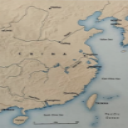Traders bearing goods and religion
Medieval Muslim traders who originated from coastal communities along the Red Sea, East Africa, and the Persian Gulf, commanded the sea routes throughout the Indian Ocean and beyond towards China. These routes were already known before the advent of Islam through the trade between the Sassanian (224-651) and Tang empires (618-906). Traders carried glass, spices, minerals, and other goods to China, where they were traded for silk, Chinese porcelain, ceramics, and lead, among other goods. But beginning in the seventh century, Muslim traders became not only bearers of goods, but also of a new religion. The traders and sailors on the ship who had the courage to embark on an adventure (from which many never returned) were the actors in the advance of Islam in the east.
The traders who sailed from one port to another to reach Chinese ports had to face difficult and precarious conditions, as the vessels were small, overloaded, and did not provide shelter. The voyagers were often exposed to harsh elements and weather conditions. They had to sail at the right time of the year in relation to the monsoons, ideally between April and September.
A representation of a ship in the Maqamat of al-Hariri, although painted in Baghdad in 1236-37, harks back to a much earlier world of Indian Ocean commerce and travel during the heyday of the Abbasid Caliphate in the ninth and tenth centuries. In the illustration, there is a freestanding pavilion on top of the ship’s weather-deck and positioned in front of the central mast. The Indian captain steers his ship from a seat at the rear of the vessel, assisted by African sailors, while a diminutive figure is shown within the front pavilion. Passengers inside the boat, who are likely Arabs and Persians, gaze out of their cabin windows. But we should not ignore another type of spatial configuration where the living spaces are built at the stern or prow of undecked vessels. A ninth-century Arab dhow, the so-called Belitung wreck, which sank off the Indonesian coast on its return journey from the Chinese ports, was shown to have been constructed without a top deck.
Whether the vessel sank because of a storm or other factors as it traversed the heart of the global trading network remains unknown. But we know that the ship was only eighteen metres long, fairly small for such a lengthy and precarious journey, and laden with an estimated 60,000 pieces of valuable cargo of Chinese porcelain and other precious objects made in Tang China and bound for Iraq. The porcelain pieces were mass produced in different kilns in China, assembled in the southeastern ports and shipped to their destinations.
Because of trade, Muslims settled along the South China coast. The sometimes long season of monsoon travel made taking a local wife and establishing a home, however temporary, a practical response to the long wait for the next boat home. The practice of polygyny within Islam and the paternal transmission of religious identity proved advantageous to Muslim traders.
The Muslim traders normally left the Chinese ports to return home between November and February because of the monsoon. Mariners had to trust in God. Before their departure, they recited prayers so their journey would unfold safely. Burning incense would have been part of the religious ceremonies that became traditional before a ship’s departure, and was intended to implore divine protection before embarking on another perilous journey.
Quanzhou, the port with the highest population of Muslim traders and which was the most important trading port in the Indian Ocean at this time, had at least seven mosques built in the Song Dynasty (960-1279). It was called ‘the emporium of the world’ from 1000-1400, and its Muslim community was as vibrant as that of the Hindus, Manichaeans and Christians during these four centuries of Song, Yuan (1279-1368) and early Ming rule (1368-1644).
A giant version of our incense burner at the Qubba in Linxia in Gansu Province is still in use today.
In any case, we think it is beautiful to look at, and can imagine it being used and used, again and again!
, (accessed 10/08/2021)](https://micrio.thingsthattalk.net/LcdSv/views/max/128x128.s.jpg)
](https://micrio.thingsthattalk.net/EsbQC/views/max/130x128.png)

](https://micrio.thingsthattalk.net/FXqhL/views/max/185x128.png)

(accessed 10/08/2021)](https://micrio.thingsthattalk.net/OuXWL/views/max/213x128.png)
](https://micrio.thingsthattalk.net/pBUFo/views/max/203x128.png)
](https://micrio.thingsthattalk.net/ClWiX/views/max/128x128.s.jpg)

